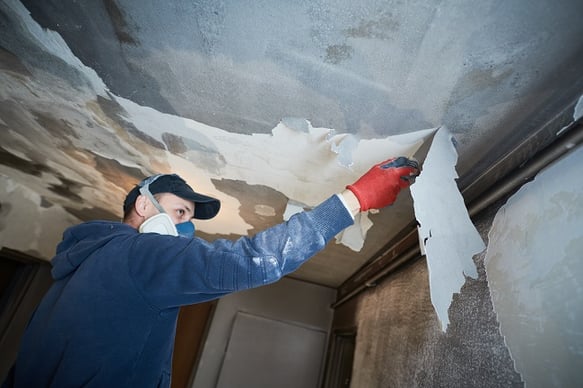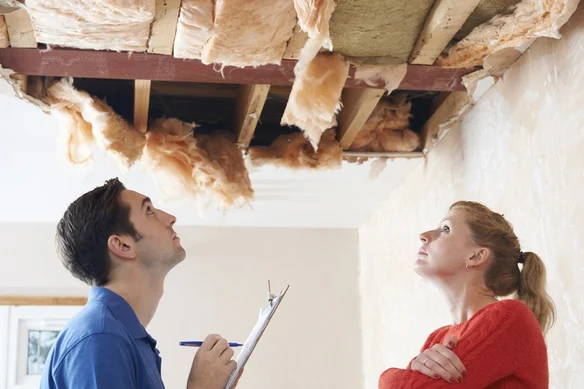Introduction
Homeowners Insurance Cover Ceiling Collapse – A sudden ceiling collapse can lead to significant damage and costly repairs. Find out if your homeowners insurance covers it and how to file a successful claim.

Understanding your policy is crucial to avoiding unexpected expenses. In this guide, we’ll break down whether homeowners insurance covers ceiling collapse, what causes it, and how you can ensure your claim gets approved.
Understanding Ceiling Collapse
What Is Ceiling Collapse?
Ceiling collapse happens when a ceiling structure weakens and falls, often damaging furniture, flooring, and even people in the room. It can be a partial or complete failure, depending on the extent of damage.
Common Causes of Ceiling Collapse
- Water Damage – Leaky pipes, roof leaks, or high humidity can weaken ceiling materials.
- Heavy Loads – Excessive weight from snow, stored items in the attic, or structural failure can cause collapse.
- Aging Structure – Older homes with deteriorating plaster or drywall are more prone to sudden collapse.
- Pest Infestation – Termites, rodents, and other pests can weaken wooden supports.
- Poor Construction – Shoddy workmanship or low-quality materials can lead to failure over time.
Does Homeowners Insurance Cover Ceiling Collapse?
In most cases, yes, homeowners insurance does cover ceiling collapse—but only under specific conditions. Insurance policies typically cover sudden, accidental damages but not gradual wear and tear.
Factors That Determine Coverage
- Cause of the Collapse – If it resulted from a covered peril (like water damage or a falling tree), insurance usually covers it.
- Maintenance History – If negligence caused the collapse, your claim could be denied.
- Policy Exclusions – Some policies exclude certain structural damages unless additional coverage is purchased.
Covered Causes of Ceiling Collapse
Insurance usually covers collapses caused by:
- Water Damage – Burst pipes, sudden leaks, or water heater failures.
- Weight of Snow/Ice – Heavy snowfall that exceeds structural limits.
- Fire Damage – Even minor fires can weaken ceilings, leading to collapse.
- Vandalism & Theft – If intruders damage your ceiling, your policy may cover repairs.
- Sudden Accidental Events – A tree falling onto your roof can cause an immediate collapse.
When Ceiling Collapse Might Not Be Covered
Your claim may be denied if the damage was due to:
- Neglect and Lack of Maintenance – Ignoring visible warning signs can result in non-coverage.
- Gradual Deterioration – Normal aging, cracks, and sagging ceilings aren’t covered.
- Pre-existing Damage – If your ceiling was already damaged, insurance won’t pay.
- Earthquakes & Floods – These require separate policies.
How to File a Homeowners Insurance Claim for Ceiling Collapse
- Take Immediate Action – Move valuable items and ensure safety.
- Document the Damage – Take pictures and videos as proof.
- Contact Your Insurance Provider – Report the incident ASAP.
- Work with Adjusters – Expect an inspection before approval.
- Get Repair Estimates – Compare contractor quotes for fair compensation.

Preventing Ceiling Collapse
- Regular Inspections – Check for water damage, cracks, and sagging.
- Fix Leaks Promptly – Address any plumbing or roof issues immediately.
- Pest Control – Keep termites and rodents at bay.
Conclusion
A homeowners insurance cover ceiling collapse policy can help protect you from unexpected damage caused by structural issues, water leaks, or accidents. If a ceiling collapse occurs, your homeowners insurance cover ceiling collapse may pay for repairs, but coverage depends on the cause. Understanding when your homeowners insurance cover ceiling collapse is essential to ensure you’re financially protected.
FAQs
Will my premium increase after filing a claim for ceiling collapse?
It depends on your provider, claim history, and policy terms.
Can I switch insurance companies after a ceiling collapse claim?
Yes, but the new provider may increase rates or exclude certain coverages.
Does renters insurance cover ceiling collapse for tenants?
No, structural damage is the landlord’s responsibility, but renters insurance covers personal property damages.

